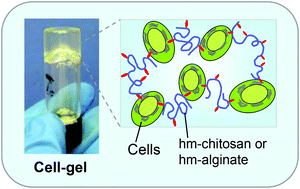Engineering tissue mimics in vitro using cells and materials is one of the core goals of biomaterials science. To develop a tailored cell culture environment, natural and/or synthetic hydrogels are used to mimic the extracellular matrix. Cells are embedded in a hydrogel matrix in a process known as “encapsulation.” During encapsulation, polymers in solution are chemically or physically cross-linked to immobilize cells in a mesh-like structure. The cell-loaded hydrogels are subsequently used for various regenerative medicine applications.
Researchers at the University of Maryland have developed a novel encapsulation technique for embedding cells in hydrogel materials. Instead of passively encapsulating cells in the polymer mesh, cells serve as “active structural elements” and are connected to the polymer chains. Using hydrophobically-modified (hm) alginate and chitosan, hydrophobic regions along the polymer chains are physically embedded in the hydrophobic cell membrane. The cells serve as struts to link together the polymer mesh. Rheological studies were performed to confirm the sol-gel transition when hm-polymers were combined to form gels (unmodified polymer controls did not form gels). To show the versatility of the system, various cell types were used to form gels with hm-alginate and hm-chitosan, including human umbilical vein endothelial cells (HUVECs), MCF7 breast cancer cells, and blood cells.
Analogous to building block toys such as Legos, the non-covalent hm-polymer and cell interactions are reversible with the addition of excess hydrophobic binding “pockets.” Using α-cyclodextrin, the gels are immediately transformed into free-flowing solutions (confirmed using rheology). The α-cyclodextrin serves to sequester the hydrophobic tails of the hm-polymer and gently release the cells from the mesh. Interestingly, α-cyclodextrin does not affect cell viability because the molecule is not large enough to bind two-tailed lipids of the cell membrane. Viability of the cells was confirmed before and after the gentle release from the gel, indicating that cell membranes remained unharmed during the gel reversal process.
Taken together, hm-polymers could serve as a unique technique to embed and release cells from a hydrogel matrix. Using cells as building blocks is highly desirable for several applications including 3D cell culture models and injectable cell therapies.
Reversible gelation of cells using self-assembling hydrophobically-modified biopolymers: toward self-assembly of tissue
Vishal Javvaji, Matthew B. Dowling, Hyuntaek Oh, Ian M. White and Srinivasa R. Raghavan
Biomater. Sci., 2014, Advance Article, DOI: 10.1039/C4BM00017J
Brian Aguado is currently a Ph.D. Candidate and NSF Fellow in the Biomedical Engineering department at Northwestern University. He holds a B.S. degree in Biomechanical Engineering from Stanford University and a M.S. degree in Biomedical Engineering from Northwestern University. Read more about Brian’s research publications here.
To keep up-to-date with all the latest research, sign-up to our RSS feed or Table of contents











